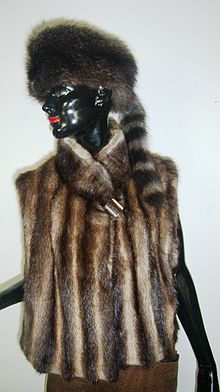The following article was sourced from a Wikipedia page at the following address: http://en.wikipedia.org/wiki/Coonskin_cap
COONSKIN CAPS

A dummy with a coonskin cap
A coonskin cap is a hat fashioned from the skin and fur of a raccoon. The original coonskin cap consisted of the entire skin of the raccoon including its head and tail. Beginning as traditional Native American headgear, coonskin caps became associated with American and Canadian frontiersmen of the 18th and 19th centuries, and were highly popular among boys in the United States, Canada and the United Kingdom in the 1950s.
ORIGIN
Coonskin caps were originally a traditional Native American article of clothing, but when European pioneers began settling the Tennessee and Kentucky areas, they made it their own, evolving its use and wearing them as hunting caps.
The coonskin cap eventually became a part of the iconic image associated with American frontiersmen such as Daniel Boone and Davy Crockett. Boone did not actually wear coonskin caps, which he disliked, and instead wore felt hats. But explorer Meriwether Lewis wore a coonskin cap during the Lewis and Clark Expedition. Joseph L. Meek wore the coonskin cap in the mountains.
An account of actor Noah Ludlow introducing the popular song "The Hunters of Kentucky" while wearing a coonskin cap is shown to be spurious in Ludlow's autobiography. Ludlow recounted that initial performance of 1822: "As soon as the comedy of the night was over, I dressed myself in a buckskin hunting-shirt and leggins, which I borrowed off a river man, and with moccasins on my feet and an old slouched hat on my head, and a rifle on my shoulder, I presented myself before the audience."
20TH CENTURY POPULARITY
Estes Kefauver
Politician Estes Kefauver of Tennessee adopted the coonskin cap as a personal trademark during his successful 1948 campaign for election to the United States Senate. Tennessee political boss E. H. Crump had published advertisements accusing Kefauver of being a raccoon-like Communist puppet. In response, Kefauver put on a coonskin cap during a speech in Memphis, proclaiming: "I may be a pet coon, but I'm not Boss Crump's pet coon." He continued to use the coonskin cap as a trademark throughout his political career, which included unsuccessful campaigns for the Democratic presidential nomination in 1952 and 1956, an unsuccessful campaign for the Vice Presidency as Adlai Stevenson's running mate in 1956, and successful Senatorial re-election campaigns in 1954 and 1960.
1950s fad
In the 20th century, the iconic association was in large part due to Disney's television program Disneyland and the first three "Davy Crockett" episodes starring Fess Parker. In the episodes, which once again made Crockett into one of the most popular men in the country, the frontier hero was portrayed wearing a coonskin cap. The show spawned several Disneyland Davy Crockett sequels as well as other similar shows and movies, with many of them featuring Parker as the lead actor. Parker went on to star in a Daniel Boone television series (1964-1970), again wearing a coonskin cap.
Crockett's new popularity initiated a fad among boys all over the United States as well as a Davy Crockett craze in the United Kingdom. The look of the cap that was marketed to young boys was typically simplified; it was usually a faux fur lined skull cap with a raccoon tail attached. A variation was marketed to young girls as the Polly Crockett hat. It was similar in style to the boys' cap, including the long tail, but was made of all-white fur (faux or possibly rabbit). At the peak of the fad, coonskin caps sold at a rate of 5,000 caps a day. By the end of the 1950s, Crockett's popularity waned and the fad slowly died out. The fad is recalled by numerous cultural references, such as the wearing of coonskin caps as part of The Junior Woodchucks uniform in Disney's Donald Duck comics.
Other uses
Coonskin caps are powerful cultural symbols that continued to be seen in film, television, and other contexts in the latter decades of the 20th century.
-
In the 1964 ABC-TV series The Addams Family, Uncle Fester occasionally wore a coonskin cap dyed black with a white strip running down the middle of both the crown and the tail, suggesting that it was made from the skin of a skunk.
-
The 1983 film A Christmas Story, which features various cultural artefacts of American childhood from the 1930s, 1940s, and 1950s, depicts a boy wearing a coonskin cap.
-
The Simpsons depicts Jebediah Springfield, the early 19th-century founder of the fictional town of Springfield, in a coonskin cap.
-
Florida politician Lawton Chiles put on a coonskin cap while celebrating his 1994 gubernatorial re-election victory over Republican Jeb Bush, recalling a campaign statement in which Chiles had predicted victory by saying "the old he-coon walks just before the light of day."
-
The Great Brain series features Parley Benson, a person who wears a coonskin cap.
-
In Walt Disney's stories, the Junior Woodchucks Huey, Dewey and Louie Duck also wear coonskin caps.
-
In the American History cartoon Histeria!, Kip Ling, the bow-haired girl, Froggo and Aka Pelly are seen wearing coonskin caps when they sing a song about Philo Farnsworth. Toast has been seen wearing one on a bus with the Kid Chorus.
-
Ferb from the American cartoon Phineas and Ferb is seen wearing a coonskin cap when he saws a log with Phineas (episode:She's the Mayor)
-
Senator Jack S. Phogbound of Li'l Abner comic strip wears a coonskin cap
To read more about coonskin caps, please click on the following link: http://en.wikipedia.org/wiki/Coonskin_cap
